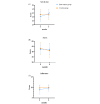Clinical Impact of Personalized Physician's Education and Remote Feedback Via a Digital Platform on Glycemic Control: Pilot Randomized Controlled Trial
- PMID: 40310669
- PMCID: PMC12082059
- DOI: 10.2196/67151
Clinical Impact of Personalized Physician's Education and Remote Feedback Via a Digital Platform on Glycemic Control: Pilot Randomized Controlled Trial
Abstract
Background: The digital education platform Doctorvice (iKooB Inc.) offers face-to-face physician-patient education during outpatient clinic visits, remote glucose monitoring, and the delivery of educational messages, and is expected to be effective for personalized diabetes care.
Objective: This study aims to evaluate the effectiveness of the digital education platform for diabetes care by comparing cases that included both face-to-face education and remote monitoring with those that included only face-to-face education.
Methods: This was a randomized clinical study conducted at the Diabetes Center of Seoul St. Mary's Hospital. Participants were aged ≥19 years and had glycated hemoglobin (HbA1c) levels between 7.5% and 9.5%. In the intervention group, physicians used the digital education platform to provide face-to-face education at enrollment and at the 3- and 6-month visits, along with remote monitoring during the first 3 months of the 6-month study period. The control group received conventional outpatient education. Both groups completed questionnaires-assessing satisfaction with diabetes treatment, diabetes-related stress, and adherence to diabetes medication-at the beginning and end of the study. The primary endpoint was the change in HbA1c levels.
Results: A total of 66 participants were enrolled between August 1, 2022, and August 31, 2023. Of these, 26 in the intervention group and 30 in the control group were analyzed, excluding 10 participants who dropped out of the study. The mean baseline HbA1c levels were 8.3% (SD 0.6%) in the intervention group and 8.0% (SD 0.5%) in the control group. At the 3-month follow-up, mean HbA1c decreased by 0.5%-7.8% (SD 0.9%; P=.01) in the intervention group and by 0.2%-7.8% (SD 0.7%) in the control group. HbA1c levels substantially improved during the first 3 months with both face-to-face education and remote glucose monitoring. However, HbA1c tended to increase during the 3- to 6-month follow-up in the intervention group without the remote monitoring service. Satisfaction with diabetes treatment significantly improved at the end of the study compared with baseline in the intervention group (mean change +3.6 points; P=.006). Medication adherence improved in both groups, with no significant difference at 6 months (P=.59), although the intervention group showed a greater increase from baseline. Subgroup analysis indicated that the reduction in HbA1c was greater for patients with baseline HbA1c levels ≥8.0%, those aged ≥65 years, smokers, drinkers, and those with obesity in the intervention group.
Conclusions: The digital education platform for personalized diabetes management may be beneficial for glycemic control in type 2 diabetes mellitus. Its effectiveness appears to be enhanced when physicians provide personalized face-to-face education combined with remote feedback.
Trial registration: Clinical Research Information Service (CRiS) of Republic of Korea KCT0007953; https://cris.nih.go.kr/cris/search/detailSearch.do?seq=23507&search_page=L.
Keywords: digital health; distance counseling; education, distance; remote patient monitoring; type 2 diabetes mellitus.
©Jin Yu, Joonyub Lee, Yeoree Yang, Eun Young Lee, Seung-Hwan Lee, Jae-Hyoung Cho. Originally published in JMIR mHealth and uHealth (https://mhealth.jmir.org), 01.05.2025.
Conflict of interest statement
Conflicts of Interest: JHC is the CEO of iKoob Inc. The other authors have nothing to declare.
Figures






Similar articles
-
The effects of professional continuous glucose monitoring as an adjuvant educational tool for improving glycemic control in patients with type 2 diabetes.BMC Endocr Disord. 2021 Apr 23;21(1):79. doi: 10.1186/s12902-021-00742-5. BMC Endocr Disord. 2021. PMID: 33888117 Free PMC article. Clinical Trial.
-
Effect of a Mobile Phone-Based Glucose-Monitoring and Feedback System for Type 2 Diabetes Management in Multiple Primary Care Clinic Settings: Cluster Randomized Controlled Trial.JMIR Mhealth Uhealth. 2020 Feb 26;8(2):e16266. doi: 10.2196/16266. JMIR Mhealth Uhealth. 2020. PMID: 32130172 Free PMC article. Clinical Trial.
-
Effects of physician's diabetes self-management education using Japan Association of Diabetes Education and Care Diabetes Education Card System Program and a self-monitoring of blood glucose readings analyzer in individuals with type 2 diabetes: An exploratory, open-labeled, prospective randomized clinical trial.J Diabetes Investig. 2021 Dec;12(12):2221-2231. doi: 10.1111/jdi.13607. Epub 2021 Jul 30. J Diabetes Investig. 2021. PMID: 34087060 Free PMC article. Clinical Trial.
-
Effectiveness of Digital Interventions for Improving Glycemic Control in Persons with Poorly Controlled Type 2 Diabetes: A Systematic Review, Meta-analysis, and Meta-regression Analysis.Diabetes Technol Ther. 2018 Nov;20(11):767-782. doi: 10.1089/dia.2018.0216. Epub 2018 Sep 26. Diabetes Technol Ther. 2018. PMID: 30257102
-
Effectiveness of shared decision-making for glycaemic control among type 2 diabetes mellitus adult patients: A systematic review and meta-analysis.PLoS One. 2024 Jul 31;19(7):e0306296. doi: 10.1371/journal.pone.0306296. eCollection 2024. PLoS One. 2024. PMID: 39083503 Free PMC article.
References
-
- Sun H, Saeedi P, Karuranga S, Pinkepank M, Ogurtsova K, Duncan BB, Stein C, Basit A, Chan JC, Mbanya JC, Pavkov ME, Ramachandaran A, Wild SH, James S, Herman WH, Zhang P, Bommer C, Kuo S, Boyko EJ, Magliano DJ. IDF Diabetes Atlas: global, regional and country-level diabetes prevalence estimates for 2021 and projections for 2045. Diabetes Research and Clinical Practice. 2022 Jan;183:109119. doi: 10.1016/j.diabres.2021.109119. https://europepmc.org/abstract/MED/34879977 S0168-8227(21)00478-2 - DOI - PMC - PubMed
-
- Choi JH, Lee KA, Moon JH, Chon S, Kim DJ, Kim HJ, Kim NH, Seo JA, Kim MK, Lim JH, Song Y, Yang YS, Kim JH, Lee Y, Noh J, Hur KY, Park JS, Rhee SY, Kim HJ, Kim HM, Ko JH, Kim NH, Kim CH, Ahn J, Oh TJ, Kim S, Kim J, Han E, Jin S, Choi WS, Moon MK. 2023 clinical practice guidelines for diabetes mellitus of the Korean Diabetes Association. Diabetes Metab J. 2023 Sep;47(5):575–594. doi: 10.4093/dmj.2023.0282. https://europepmc.org/abstract/MED/37793979 dmj.2023.0282 - DOI - PMC - PubMed
-
- Deakin TA, Cade JE, Williams R, Greenwood DC. Structured patient education: the diabetes X-PERT Programme makes a difference. Diabet Med. 2006 Sep;23(9):944–54. doi: 10.1111/j.1464-5491.2006.01906.x. https://eprints.whiterose.ac.uk/79639/ DME1906 - DOI - PubMed
Publication types
MeSH terms
Substances
LinkOut - more resources
Full Text Sources
Miscellaneous

